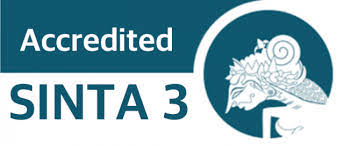(PLANNING THE DISTIBUTION OF PIPING NETWORKS WITH PUMP SYSTEM USING THE EPANET 2.0. PROGRAM (CASE STUDY: RAJABASA SUBDISTRICT BANDAR LAMPUNG CITY))
PERENCANAAN DISTRIBUSI JARINGAN PERPIPAAN DENGAN SISTEM POMPA MENGGUNAKAN PROGRAM EPANET 2.0. (STUDI KASUS: KECAMATAN RAJABASA BANDAR LAMPUNG)
Abstract views: 182 | pdf downloads: 1208
Abstract
Generally, the distribution of clean water uses a distribution pipe network system consisting of pipes, pumps, reservoirs and others. With distribution pipe system, expected to be able to meet the water needs of domestic and non-domestic people. The increase in population will cause in greater consumption patterns of water demand. This research is focused on planning the piping network system in the distribution of water to fulfill the water demand of the people who has not been served entirely. The research location is in Rajabasa District, Bandar Lampung City. Based on a survey in the form of filling out questionnaires, people water use is 108.02 liters/person/day. The population growth rate is 4.23% so it is projected until 2040 to estimate volume clean water demand for people. Based on the Arithmetic Method, the population in Rajabasa Subdistrict is 106,235 people. In planning the pipeline network, a simulation of the distribution of clean water is carried out with the Epanet 2.0 Program. The model is designed and then simulated with network link and netrwok nodes in determining pipe diameters and pump systems. The pump system is used because a number of service areas are higher than the reservoir position in Rajabasa District. Based on the simulation, a reservoir is planned which is required to be able to hold water for the next 20 years. The reservoir capacity is 1,136 m3 so that the planned reservoir dimensions are 19 x 16 x 4 m and are expected to be able to fulfill the water demand of the people.
References
Al-Layla, M.A. (1987). Water Supply Engineering Design. Michigan: Ann Arbor Science Publisher Inc.
Juwono, P. T., & Subagiyo, A. (2018). Sumber Daya Air dan Pengembangan Wilayah: Infrastruktur Keairan Mendukung Pengembangan Wisata, Energi dan Ketahanan Pangan (1 ed.). Universitas Brawijaya.
Lampung, B. P. (2021). Kecamatan Rajabasa Dalam Angka 2021. Bandar Lampung: Badan Pusat Statistik.
Maulidya, L. N., Prayogo, T. B., & Bisri, M. (2018). Studi Perencanaan dan Pengembangan Jaringan Distribusi Air Bersih di Kecamatan Tumpang Kabupaten Malang menggunakan Software Epanet 2.0.
Nelwan, F., Wuisan, E. M., & Tanudjaja, L. (2013). Perencanaan Jaringan Air Bersih Desa Kima Wori. Jurnal Sipil Statik, 679
Pudyastuti, P. S., W, G. D., Fatchan, A. K., & Kuswantomo. (2017). Rekayasa Irigasi Dan Bangunan Air. Surakarta: Muhammadiyah University Press.
Rossman, L. A. (2000). EPANET 2.0. Users Manual. Cincinnati: U.S. Environmental Protection Agency.
Syofzan, Z. (2017). Analisa Ketersediaan Air Bersih untuk Kebutuhan Penduduk di Kecamatan Pauh Kota Padang. Seminar Nasional Strategi Pengembangan Infrastruktu ke-3 (SPI-3), 57.
Peraturan Menteri Pekerjaan Umum (2007) Tentang Penyelenggaraan Pengembangan Sistem Penyediaan Air Minum 18/PRT/M2007.
Copyright (c) 2023 Jurnal Infrastruktur

This work is licensed under a Creative Commons Attribution-NonCommercial-ShareAlike 4.0 International License.














